I'm working on a multi-story building that was constructed in the early 1900s. Exterior walls are stone. Interior framing is wood joists with steel girders and columns. The roof is gabled with several dormers. In the attic, I ran into this wood roof truss with a pipe "hanger" (see pic) which appears to be missing a portion of the bottom chord in the center. However the "missing" segment of the bottom chord appears to be intentional and not a modification. I'm thinking that this was part of the original design and that the truss behaves in some manner that I'm not familiar with. It does not appear to engage the attic floor framing and seems to support only the roof. Has anyone run across a truss like this in their adventures?
Navigation
Install the app
How to install the app on iOS
Follow along with the video below to see how to install our site as a web app on your home screen.
Note: This feature may not be available in some browsers.
More options
Style variation
-
Congratulations cowski on being selected by the Eng-Tips community for having the most helpful posts in the forums last week. Way to Go!
You are using an out of date browser. It may not display this or other websites correctly.
You should upgrade or use an alternative browser.
You should upgrade or use an alternative browser.
Has anyone seen a wood truss like this? 4
- Thread starter albanyYEM
- Start date
- Status
- Not open for further replies.
- Thread starter
- #2
Here is a view of the top chord where the "hanger" is connected to the left of the view.
- Thread starter
- #6
The ends are pocketed into the exterior walls. There appears to be a slight bow at the walls to indicate an outward thrust. It appears to have been working like this for 100+ years. I would think if the chord had been cut it would have lead to some noticeable if not catastrophic failure. I'm not 100% sure but there is also some evidence that the space used to be occupied and that the bottom chord could have been intermittent so as not to be an obstacle along the floor.
I'm attaching a rough elevation view of the truss (the rest of my pics did not come out well). The yellow lines are the wood (8x8 overall) and the red lines are the pipe "hangers". The blue is the attic floor below which I believe to be separate from this truss system.
I'm just wondering if this is some type of framing strategy that was used back in the day which i've just never seen before.
I'm attaching a rough elevation view of the truss (the rest of my pics did not come out well). The yellow lines are the wood (8x8 overall) and the red lines are the pipe "hangers". The blue is the attic floor below which I believe to be separate from this truss system.
I'm just wondering if this is some type of framing strategy that was used back in the day which i've just never seen before.
My bet it was a triangle arrangement ounce mainly to keep the bottom ends of the top chord from spreading outward. Then along comes a guy like
Frank Lloyd Wright and figures it is in the way of something and he cuts off the bottom chord. Note the color of the cut looks more fresh than the sides of the plank.
Frank Lloyd Wright and figures it is in the way of something and he cuts off the bottom chord. Note the color of the cut looks more fresh than the sides of the plank.
-
1
- #8
Weird, for sure. I did find a few old truss design pages showing rods, but all with continuous bottom chords. Attached here for fun.
Is there any way the rods extend through to grab beams in the floor system?
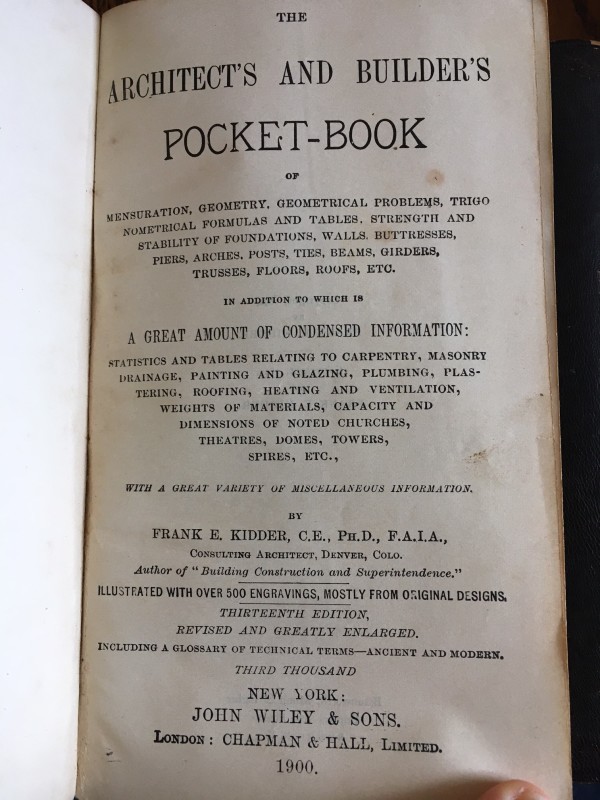
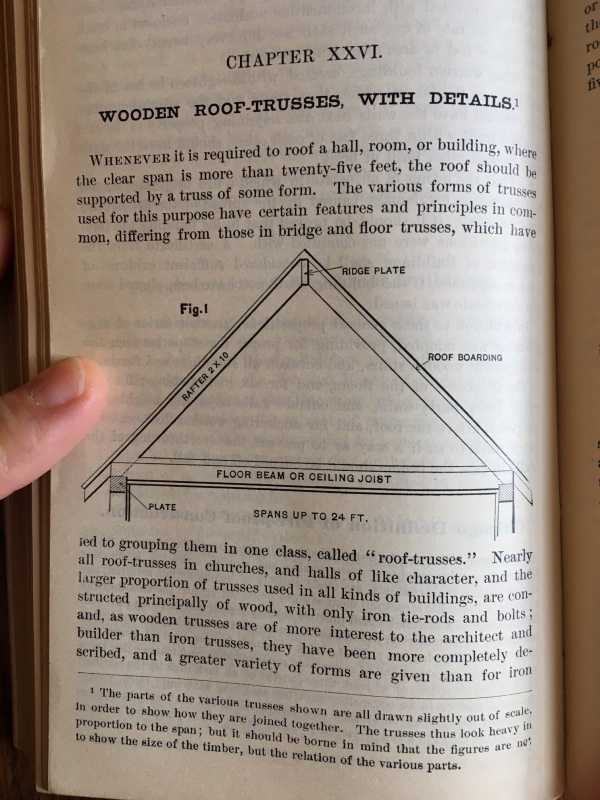


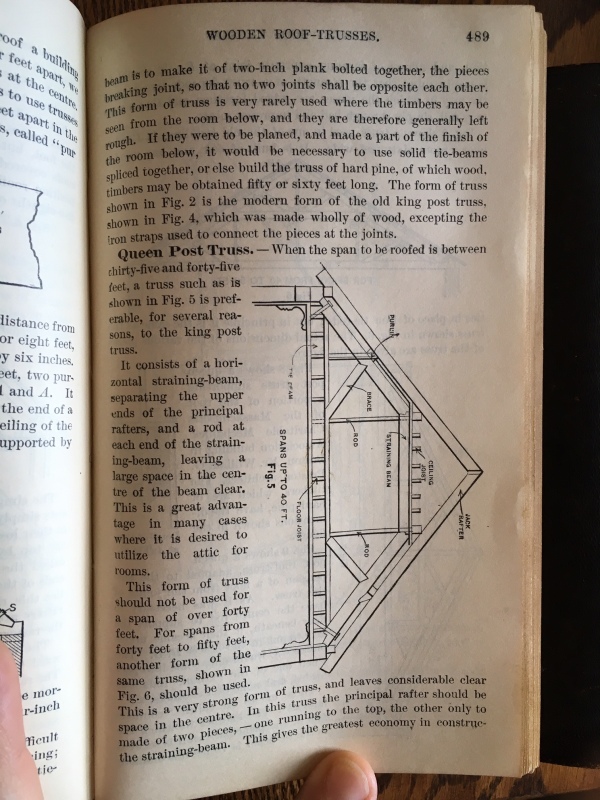
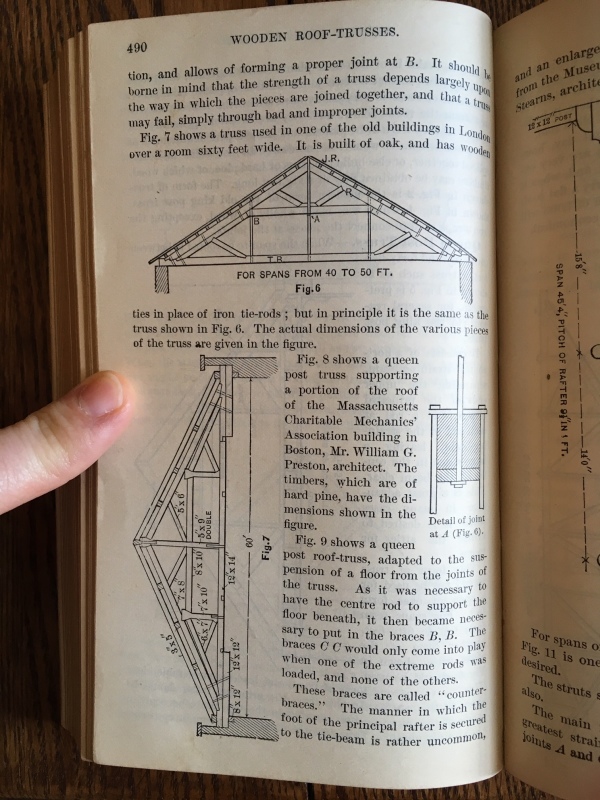
Please remember: we're not all guys!
Is there any way the rods extend through to grab beams in the floor system?






Please remember: we're not all guys!
- Thread starter
- #9
Thank you for all comments. I don't think the rods connect to the floor because the attic floor framing is perpendicular to the truss span and there is no girder below (and parallel) to the truss.
I disagree that the "cuts" look fresher. I think if anything they may look slightly lighter because they are reflecting the camera flash. To my eye the finish looks the same on the end as on the sides of the chords. They do not appear rough at all.
So here's my dilemma:
We aren't changing anything with this attic framing but my client has requested a peer review for our project because a recent project in a similar building (that I was not involved in) had some structural issues and became very embarrassing for the client's administration. So i'm walking the peer reviewer around the building, we head up to the attic and they say "holy crap, they cut the bottom chord of that truss!".
This was a condition that definitely confused me, but has been performing satisfactorily as-is for decades so i wasn't going to recommend any action. Now i have a peer reviewer who will likely recommend connecting the bottom chord. Normally i'd say yes, let's do this, but if the bottom chord becomes continuous it then causes me several issues with foot traffic in this space.
Trying to determine if I should just connect the bottom chord and deal with the challenges. Or advance a case that this isn't a safety issue. Thoughts?
I disagree that the "cuts" look fresher. I think if anything they may look slightly lighter because they are reflecting the camera flash. To my eye the finish looks the same on the end as on the sides of the chords. They do not appear rough at all.
So here's my dilemma:
We aren't changing anything with this attic framing but my client has requested a peer review for our project because a recent project in a similar building (that I was not involved in) had some structural issues and became very embarrassing for the client's administration. So i'm walking the peer reviewer around the building, we head up to the attic and they say "holy crap, they cut the bottom chord of that truss!".
This was a condition that definitely confused me, but has been performing satisfactorily as-is for decades so i wasn't going to recommend any action. Now i have a peer reviewer who will likely recommend connecting the bottom chord. Normally i'd say yes, let's do this, but if the bottom chord becomes continuous it then causes me several issues with foot traffic in this space.
Trying to determine if I should just connect the bottom chord and deal with the challenges. Or advance a case that this isn't a safety issue. Thoughts?
albanyYEM,
Yeah, my first reaction was "Holy crap, they cut the bottom chord of that truss!" Very interesting...
SLTA,
Could you post a picture of the cover of the reference? What is the copyright date? I would love to add that to my modest collection!
EIT
Yeah, my first reaction was "Holy crap, they cut the bottom chord of that truss!" Very interesting...
SLTA,
Could you post a picture of the cover of the reference? What is the copyright date? I would love to add that to my modest collection!
EIT
It is definitely a safety issue. Even if the bottom chord had been continuous, the "truss" is not a truss in the usual sense as it lacks a central diagonal.
An adequate tension chord is required unless you are satisfied that the stone walls are capable of resisting the required thrust. As well, the tied arch must have sufficient moment capacity at the upper two joints to resist unsymmetrical loading.
BA
An adequate tension chord is required unless you are satisfied that the stone walls are capable of resisting the required thrust. As well, the tied arch must have sufficient moment capacity at the upper two joints to resist unsymmetrical loading.
BA
like BA - the "truss" is not a truss in the usual sense .....
OP: "It does not appear to engage the attic floor framing" But IF it does engage the attic floor framing, that framing may provide the missing 'tension' continuity we are looking for....
and IF, so, if the system racked to the right, the right side rod would engage and resist the movement it in tension. If it racked left, the left rod would engage and resist that movement in tension.
as it is, it's kind of a compressive archy thing
Kind of wonder if it was a clever do-it-yourselfer from another era. 100 years +.... not bad
OP: "It does not appear to engage the attic floor framing" But IF it does engage the attic floor framing, that framing may provide the missing 'tension' continuity we are looking for....
and IF, so, if the system racked to the right, the right side rod would engage and resist the movement it in tension. If it racked left, the left rod would engage and resist that movement in tension.
as it is, it's kind of a compressive archy thing
Kind of wonder if it was a clever do-it-yourselfer from another era. 100 years +.... not bad
AlbanyYEM:
That does not appear to be a gable roof from you interior photos, rather it is a hip roof, with sloped sides and ends. In your second photo, the beam that runs the length of the bldg. is a mid-rafter support member. Timber framers have a specific name for these, and it escapes me at the moment. The funny truss in question is a continuation of this mid-rafter support system, at the hip ends. I think that oldestguy is on to something, in that the bottom chord of the truss may have been continuous at one time. You can see some shadow of that in the current floor system, extending beyond what appears to be the cut end of the bot. chord, near the hanger. That bot. chord is undoubtedly nailed to the floor system in some way, and is using that floor system as a diaphragm, which has limited the outward thrust or bowing that you claim to see in the stone masonry walls. That mid-span rafter support beam should be supported by a couple stub columns, onto walls below, on a long bldg.
You could relieve the outward thrust with a couple tie rods and a turnbuckle which could be hidden in a new floor topping of some sort, or with some sort of a post tensioning rod or some such. The photos show things that look a little cobbled, but this was not a dumb or unthinking carpenter/framer. The numbers may not check exactly, he was using a framing square and experience, not a super computer. The mid-span rafter support takes care of some gravity loads and rafter span length, and some thrust/lateral loads, rafter to support beam (kinda like a collar tie) at that elevation. There also appears to have been a lath-n-plaster ceiling up on the horiz. ceiling and part way down the sloped roof surface, witness the white markings. Without knowing what you are trying to do or to prove, I don’t know what else to say.
That does not appear to be a gable roof from you interior photos, rather it is a hip roof, with sloped sides and ends. In your second photo, the beam that runs the length of the bldg. is a mid-rafter support member. Timber framers have a specific name for these, and it escapes me at the moment. The funny truss in question is a continuation of this mid-rafter support system, at the hip ends. I think that oldestguy is on to something, in that the bottom chord of the truss may have been continuous at one time. You can see some shadow of that in the current floor system, extending beyond what appears to be the cut end of the bot. chord, near the hanger. That bot. chord is undoubtedly nailed to the floor system in some way, and is using that floor system as a diaphragm, which has limited the outward thrust or bowing that you claim to see in the stone masonry walls. That mid-span rafter support beam should be supported by a couple stub columns, onto walls below, on a long bldg.
You could relieve the outward thrust with a couple tie rods and a turnbuckle which could be hidden in a new floor topping of some sort, or with some sort of a post tensioning rod or some such. The photos show things that look a little cobbled, but this was not a dumb or unthinking carpenter/framer. The numbers may not check exactly, he was using a framing square and experience, not a super computer. The mid-span rafter support takes care of some gravity loads and rafter span length, and some thrust/lateral loads, rafter to support beam (kinda like a collar tie) at that elevation. There also appears to have been a lath-n-plaster ceiling up on the horiz. ceiling and part way down the sloped roof surface, witness the white markings. Without knowing what you are trying to do or to prove, I don’t know what else to say.
MikeHalloran
Mechanical
I wonder if the attic floor might conceal a hefty sister under the gap, half again longer than the gap, fastened to the bottoms of the partial bottom chord pieces.
Hey, it could happen; can you get a camera into that space?
... or the room/wall/whatever below?
Mike Halloran
Pembroke Pines, FL, USA
Hey, it could happen; can you get a camera into that space?
... or the room/wall/whatever below?
Mike Halloran
Pembroke Pines, FL, USA
-
2
- #17
@Deadblow: I had a hankering for SLTA's reference too. It can be had as a PDF here: Link
I like to debate structural engineering theory -- a lot. If I challenge you on something, know that I'm doing so because I respect your opinion enough to either change it or adopt it.
I like to debate structural engineering theory -- a lot. If I challenge you on something, know that I'm doing so because I respect your opinion enough to either change it or adopt it.
Below, I've outlined my theory as to what the original design intent was. My guess is certainly no better than anyone else's since, thankfully, I'm not quite 140 years old. I have seen a similar arrangement before though. My guess is that the "bottom chord" is really just ballast weight.
ASSUMPTIONS BASED ON THE AGE OF THE BUILDING
1) There was probably no one involved in the design of the building that we'd call a "structural engineer" in the modern sense. The design team was probably some combination of architect and craftsman.
2) It would have been taken for granted that the floor deck of the attic could function as a tension tie, regardless of the orientation of the floor framing with respect the applied thrust. And, based on the success of this building and others I've encountered of a similar strife, that assumption seems to have been correct.
3) There was probably no awareness of the diaphragm action available via the sheathing other than direct tension capacity. The role of the diaphragm in resisting in plane shear would likely have gone unaccounted for.
4) No explicit consideration of lateral loads or uplft.
5) Practically, no such thing as moment connections.
PROPOSED ORIGINAL DESIGN INTENT (IMAGINE YOURSELF AS THE DESIGNER)
1) You build this hinged arch thing to provide gravity support for your beams, assuming that the arch supports are pinned laterally.
2) Because you're a smarty, you recognize that the two hinges present in the arch render it, at best, unstable and, at worst, out of equilibrium for unbalanced loading. This is true both during the temporary erection case and in final service because you don't really know about -- or have faith in -- structural diaphragms. What to do, what to do???
3) Racking instability of the arch thing involves the upward movement of one of your pinned joints. So, you hang a nice heavy timber beam from that joint to keep the joint from wandering off into space.
4) Call it a day and go chillax with the sister wives.
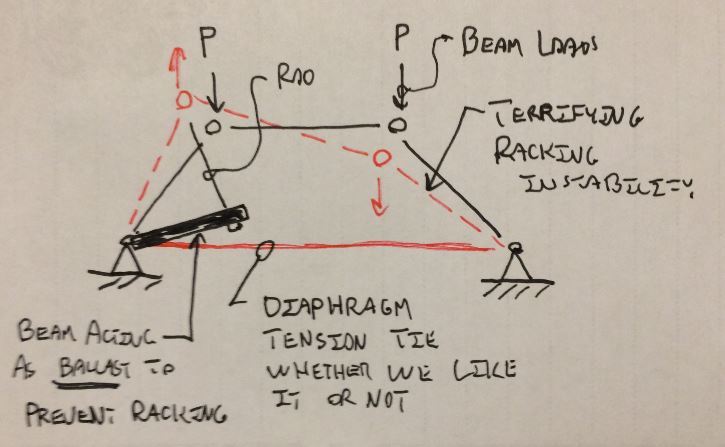
I like to debate structural engineering theory -- a lot. If I challenge you on something, know that I'm doing so because I respect your opinion enough to either change it or adopt it.
ASSUMPTIONS BASED ON THE AGE OF THE BUILDING
1) There was probably no one involved in the design of the building that we'd call a "structural engineer" in the modern sense. The design team was probably some combination of architect and craftsman.
2) It would have been taken for granted that the floor deck of the attic could function as a tension tie, regardless of the orientation of the floor framing with respect the applied thrust. And, based on the success of this building and others I've encountered of a similar strife, that assumption seems to have been correct.
3) There was probably no awareness of the diaphragm action available via the sheathing other than direct tension capacity. The role of the diaphragm in resisting in plane shear would likely have gone unaccounted for.
4) No explicit consideration of lateral loads or uplft.
5) Practically, no such thing as moment connections.
PROPOSED ORIGINAL DESIGN INTENT (IMAGINE YOURSELF AS THE DESIGNER)
1) You build this hinged arch thing to provide gravity support for your beams, assuming that the arch supports are pinned laterally.
2) Because you're a smarty, you recognize that the two hinges present in the arch render it, at best, unstable and, at worst, out of equilibrium for unbalanced loading. This is true both during the temporary erection case and in final service because you don't really know about -- or have faith in -- structural diaphragms. What to do, what to do???
3) Racking instability of the arch thing involves the upward movement of one of your pinned joints. So, you hang a nice heavy timber beam from that joint to keep the joint from wandering off into space.
4) Call it a day and go chillax with the sister wives.

I like to debate structural engineering theory -- a lot. If I challenge you on something, know that I'm doing so because I respect your opinion enough to either change it or adopt it.
It's possible that there is a beam below the floor deck which completes the tension tie for the bottom chord or as Kootk suggests, maybe the floor deck provides the tie. Also, perhaps the roof deck behaves, to some extent, like a thin shell.
Completing a tension tie above the floor and adding a couple of knee braces at the upper two joints seems like a prudent measure to ensure the ongoing safety of the structure.
BA
Completing a tension tie above the floor and adding a couple of knee braces at the upper two joints seems like a prudent measure to ensure the ongoing safety of the structure.
BA
- Status
- Not open for further replies.
Similar threads
- Replies
- 1
- Views
- 9K
- Replies
- 16
- Views
- 9K
- Replies
- 48
- Views
- 18K
- Replies
- 14
- Views
- 5K
- Locked
- Question
- Replies
- 29
- Views
- 8K
